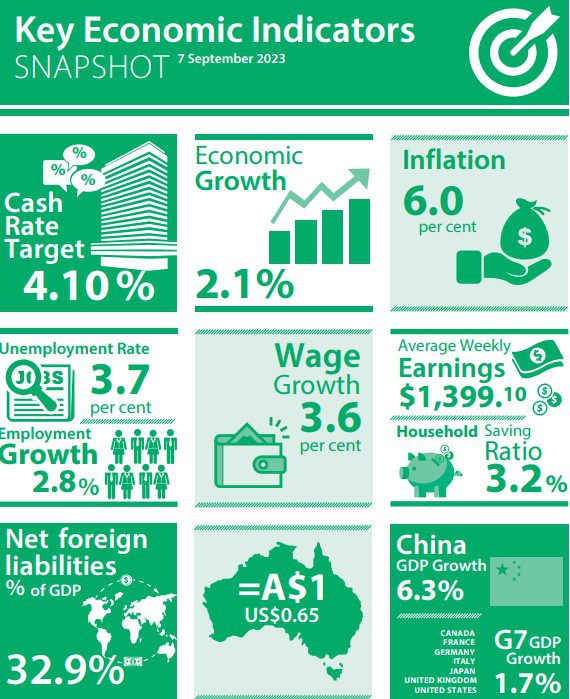
September – Jay Wu Report
Greetings and welcome to the September installment of our monthly newsletter. As we venture into the final quarter of 2023, we are thrilled to provide you with the most current perspectives on the real estate market, the financial landscape, and the state of the economy.
Economic Indicators

Real Estate Market
Housing Recovery accelerating
The Australian real estate market continues to show remarkable improvement, with the national dwelling value index marking its sixth consecutive monthly rise, up 0.8% in August. Since bottoming out in February 2023, national home values have seen a substantial 4.9% increase. This recovery is being led by Sydney, boasting an impressive 8.8% rise, closely followed by Brisbane with a 6.2% surge.
In a noteworthy trend, the national house value has surged by 6.3%, while units have seen a commendable 4.9% increase since their low point in February. This indicates a broad-based recovery across different segments of the housing market.
One of the key factors contributing to this upward trend is the lower-than-average advertised supply levels. This scarcity of available properties has created upward pressure on home values, with total supply levels down by a significant 15.5% compared to a year ago, and a striking 19% below the five-year average.
Brisbane’s Remarkable Ascent
Brisbane is standing out as a powerhouse in the national growth surge, leading for the second consecutive month with an impressive 1.5% increase in property value in August. This trend is further emphasized by the fact that listing numbers in the region are currently trending 40% below the five-year average.
Potential Headwinds:
However, as we look ahead, there are several potential headwinds to monitor:
- Rising Stock Levels: The spring selling season typically sees an influx of new listings. Keeping an eye on stock levels will be crucial in the coming months.
- Regional Variations: Some regions have witnessed a subtle rise in total listings, which has led to a deceleration in value growth.
- Credit Hurdles: Buyers continue to face challenges in accessing the housing market, particularly due to stringent credit assessment criteria, with borrowers being assessed to service loans at rates three percentage points above current mortgage rates.
- Consumer Sentiment: Persistently low consumer sentiment is another factor dampening home buying activity.
- Mortgage Stress: With the potential for higher interest rates, more households may face mortgage stress, potentially leading to more homes being put on the market.
Potential Tailwinds:
Amidst these challenges, there are also positive factors to consider:
- Inflation Drop: Falling inflation rates may offset some of the mortgage stress.
- Low Unemployment: The unemployment rate remains below the long-term average at 5.4%.
- Migration-Driven Demand: Housing demand from net overseas migration is expected to remain a prominent feature in the market in the coming years.
- Housing Shortage: Estimates from NHFIC forecast that Australia’s housing sector will be undersupplied by around 175,000 dwellings by 2027.
In summary, the Australian real estate market continues to display resilience and growth, with varying dynamics across regions. While potential headwinds exist, the market is bolstered by several tailwinds that suggest a promising outlook. As we move further into the spring season, keeping a close watch on these factors will be essential for a comprehensive understanding of the evolving real estate landscape.
Financial Market
Reporting season August
In August, markets faced challenges from central banks’ extended rate outlook, surging bond yields, and weak economic data in China and Europe. Mid-month, a ‘soft-landing’ narrative emerged, mitigating earlier losses. The MSCI World index dropped 1.7%, while emerging markets fell 4.7%. Bond markets had a sharp sell-off but recovered slightly by month-end, with the Bloomberg Global Agg down 1.4% (local currency returns).
The U.S. 10-year Treasury yield peaked at 4.35%, up 60bps from mid-July due to increased supply, robust economic data, and discussions on the neutral interest rate.
In the Eurozone, economic momentum waned, with the composite Purchasing Managers’ Index at its lowest since 2012. Tight labor markets, high inflation (5.3% y/y in August), and weaker demand for exports were challenges.
Chinese economic data disappointed, with negative inflation (-0.3% y/y in July), sluggish retail sales (2.5% y/y), and declining private investment (-2.3% in July). Policymakers took incremental steps to stabilize the economy, but they are expected to provide stability rather than robust growth in the short term. The pace of policy action increased in August, raising hopes for a better outlook.
Despite China’s economic challenges, global central banks are approaching the end of rate hikes. Markets now look to potential 2024 rate cuts, expecting lower bond yields and a more favorable environment for equities.”
If you have any further questions or would like to discuss your personal situation in more detail, please do not hesitate to contact me on 0402 686 929